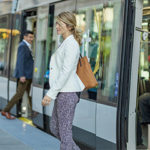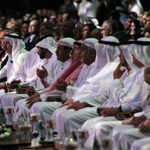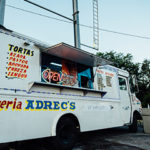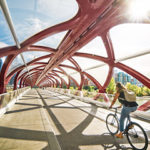Looking west from the 124th-floor observation platform of the Burj Khalifa in Dubai, toward the Arabian Gulf, it’s possible to spot the hotels and beaches of Palm Jumeirah, the world’s largest artificial island. Visitors to the 160-story Burj Khalifa, the tallest building in the world, enter through the Dubai Mall, the world’s biggest shopping mall, complete with a massive aquarium, a theme park, and the Dubai Fountain, which present water, music, and light shows on the world’s largest orchestrated fountain system.
The fourth-most-visited destination in the world, the city is an expanse of glittering hotels and skyscrapers and over-the-top attractions like an indoor ski resort, complete with ski lift. But there’s a businesslike side to the city-state: For most of the world, the city is a convenient gateway to emerging markets in Asia and Africa. One-third of the world’s population can fly to Dubai in four hours or less. The city as a business destination was the focus of the 2015 Dubai Meetings Forum, hosted by PCMA and Dubai Business Events on Dec. 5–7.
SAFETY AND DIVERSITY
A group of 19 senior meeting professionals traveled from the United States and Europe to learn more about meeting in Dubai and to exchange knowledge with local suppliers and association executives. The Forum was held in the year-old, 54-story Sheraton Grand Hotel Dubai, which also served as our home base during the week. The 474-room, five-star hotel is part of a thicket of high-rise properties that have cropped up in recent decades along Sheik Zayed Road, one of the city’s main business arteries.
Many first-time visitors make a stop at the Sheikh Mohammed Centre for Cultural Understanding (SMCCU), which was established in 1998 to help demystify Dubai’s history and culture. (Its motto: “Open Doors. Open Minds.”) In our case, the SMCCU came to us, in the form of General Manager Nasif Kayed, who welcomed the group wearing a snowy robe and headdress, known locally as a taub and a keffiyeh. Kayed spoke frankly about perceptions about the UAE, including its safety and location in the Middle East, a topic that has everyone a little skittish these days.
“You think we are all oil-rich Arabs,” Kayed said wryly, “and that we are terrorists, and all have four wives.” In reality, Dubai has a diversified economy and is one of the safest cities in the world, he said. And the emirate prides itself on its multicultural population, which is 90-percent expatriate and 10-percent UAE natives.
The Sheraton is just a few minutes from the Dubai World Trade Centre, which — with more than 1 million square feet of meeting and exhibition space — is the largest meeting facility in the Middle East. After a quick walk through the bustling center, which hosts about 500 local, regional, and international events each year, we toured its underground kitchen facilities. The culinary staff, who cater for royal weddings in Dubai, treated us to a sumptuous feast served in the kitchen’s employee dining room.
NEW OLD ARABIA
There also was time built into the Forum’s schedule to learn more about the local culture. We ventured in a caravan of four-wheel-drive vehicles into the desert, where our drivers introduced us to “dune-bashing.” After an exhilarating half-hour swooping over the undulating dunes, we calmed our racing hearts with a more meditative stop. Our hosts arranged for a twilight reception, where we toasted the sunset with Champagne and learned from falconer Pete Bergh of Royal Shaheen Falconry about how the raptors helped the Bedouin people survive in the desert by hunting.
Dinner that night was in a desert camp lit by lanterns, where, seated on cushions around low tables, we dined on Arabian specialties cooked over charcoal fires. Afterward, we were entertained with traditional dances, including the whirling Egyptian tanoura — updated by LED lights that outlined the dancer’s embroidered clothing.
Our farewell dinner was held at the Madinat Jumeirah, a hotel, dining, and conference facility built to recreate the architecture and landscape of old Arabia. The property includes a private beach, two hotels, traditional summer houses, and villas, along with more than 40 restaurants and bars. Guests navigate the Madinat Jumeirah’s three kilometers of artificial waterways in wooden abras, traditional gondola-style boats, and can shop at a souk that’s patterned after centuries-old markets.
The conference center, which was preparing to host the 12th Dubai International Film Festival the evening we visited, includes a 1,000-seat amphitheater and nearly 10,000 square feet of meeting space, plus an outdoor terrace, surrounded by water and gardens. The world doesn’t need another minimalist hotel, according to Tahir Ciyanci, Madinat Jumeirah’s sales manager, who took us on tour of the facility. He said: “We want visitors to have an authentic experience.”





